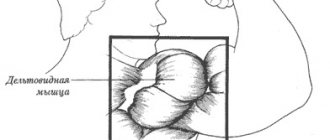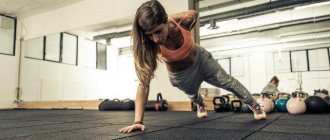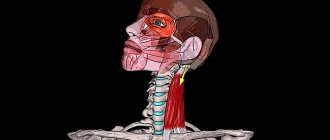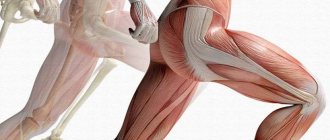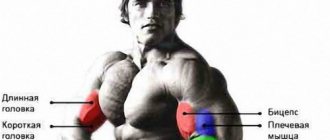First you need to understand that all people have slightly different muscle sizes on the right and left sides of the body, and to some extent this is normal. Let’s say that right-handed people usually have larger muscles on their right limbs than on their left ones, and in left-handed people, on the contrary, the muscles on the left side of the body are better developed. The size of the muscles is different for everyone, it’s just that usually this difference is not significant, so they are invisible to the eye. But if you take a centimeter and take measurements, you will notice that in fact, the size of the muscles on the right and left hemispheres of the body are slightly different.
I repeat that a slight difference in muscle development is normal and due to nature. Just like the strength of the right and left hands differs. However, for various reasons, it happens that muscle sizes differ greatly. This is immediately noticeable to the eye, and, of course, does not look very good.
Now let's move on to information on how to correct problems in muscle development.
First:
During training, you need to perform exercises so that the load on the right and left sides is always the same. The body builds muscles in response to loads, so if the loads are the same, then the muscles will develop evenly. You need to perform the same number of repetitions for the right and left sides, and always follow a clear technique for performing the exercises. If you do exercises crookedly, for example, pressing a barbell crookedly, then the load on one side will be greater than on the other and the muscles will develop unevenly, so always follow a clear technique in all exercises. Monitor yourself by looking in the mirror, or ask a friend to watch you do the exercise.
Some people find it difficult to use dumbbells of different weights. For example, when performing for the lagging side, take the dumbbell a little heavier. Remember, you can’t do this! This disrupts the technique of the exercise, develops incorrect movement skills, and can lead to injury.
Moreover, if one side is weaker, then what is the point of taking more weight for it? It turns out that the strong side won’t finish the job, and the weak side simply won’t be able to pull it off, and will get tired sooner. Remember, you just need to train correctly, follow the technique of doing the exercises, load the muscles equally, and then over time they will equalize in size and develop evenly in the future.
Second:
You need to train regularly. Muscle development takes time, so be patient, exercise regularly, and soon you will notice that the muscles will even out in size and begin to develop harmoniously. If you exercise only once a week, or often quit training, then where can you expect good results?
Third:
If there is a very large difference in muscle size, you can use additional approaches for the lagging side. For example, if you have one pectoral muscle that is significantly smaller than the other, then after you have done all the exercises for the pectoral muscles, after working them evenly, you can do one additional set for the lagging side. It's the same if you have one biceps less. After you have completed the entire biceps program, you can do one additional set for the smaller biceps.
There is no need to give too much additional load to the lagging side. You will simply overtrain your muscles, they will not have time to recover, and in the next workout they will work much worse. Train the muscles evenly, and load both sides equally, and for those muscles that are smaller, you can do one additional approach at the end of the total complex. Add loads to your weak side little by little. And give the muscles time to even out.
To additionally target the muscles on just one side, use dumbbell exercises or machine exercises. For example, to work one pectoral muscle, you need to use a dumbbell bench press. You take dumbbells, lie down, and perform a press with only one arm. You take two dumbbells in order to maintain balance and perform the press smoothly. You can also perform one-arm presses on a special chest machine. You can also do one-arm push-ups. There are also exercises that are performed with one hand with dumbbells. For example, curling your arms with dumbbells on a special bench that isolates the biceps. Or, bending one arm with emphasis on the hip.
For any muscle, you can choose a special exercise that loads only one side. However, I recommend using these methods only as a last resort if you have a very large difference in muscle size, or, for example, you are recovering muscles after an injury and you need to specifically work out some part of the body. Otherwise, just train regularly. Load your muscles equally and follow the exercise technique, and then your muscles will develop evenly. This is what we should strive for.
Fourth:
In some sports, where one part of the body works much more than the opposite, athletes may experience severe imbalances in muscle development on the right and left sides. Following from this, it is better for all athletes to include general physical training complexes in their training, and do exercises that work the muscles on both sides, that is, they always work with the whole body. Then your muscles will grow evenly and harmoniously, and this will allow.
So:
- Regular training
- Strict adherence to exercise technique
- Whole body work
These actions will help you develop harmoniously.
Video - The right hand is larger than the left, Muscles of different sizes
the right hand is larger than the left
Almost all skeletal muscles in our body are paired and located symmetrically - on the right and left. Muscle imbalance is a violation of symmetry, a discrepancy in the size and strength of paired muscles or muscle groups.
In some cases, an imbalance can be noticed, for example, when one arm or pectoral muscle is noticeably larger than the other, in others the difference is not so obvious, but is felt during training.
For example, if one arm is stronger than the other, the bar may tilt to one side during a bench press because the stronger arm will push it up faster.
Imbalances can also occur between major muscle groups, such as the back and chest, triceps and biceps, upper legs and calf muscles.
Not only does it look bad and reduce athletic performance, but it can also lead to injury. For example, if an athlete has a pumped chest and poorly developed back muscles, this increases the risk of injuring the shoulders.
In addition, muscle imbalance leads to poor posture. For example, weak back extensors and tight, clenched abdominal muscles are characteristic of a slouched posture, while tight hip flexors can cause.
Types of asymmetry
Pathogenetics identifies bust disproportions caused by increased growth (hyperplasia) and poor development (hypoplasia). Disproportions in the development of the mammary glands are divided into the following stages:
- Mild disproportion. The asymmetry between the breasts is practically invisible. This degree is not subject to medical intervention. Specially selected underwear corrects the dissonance.
- Second degree. The mammary glands vary by 1/3 in size.
- Difficult stage. If one breast is 2 or more times larger than the other. The proportion of the body is significantly disturbed.
In the practice of plastic surgery, different breasts are found in numerous variations (the glands differ in the degree of prolapse of one part, the location of the areola and nipple). Based on the geometric shapes of the bust in the female body, the following types of asymmetry are divided:
- Marked asymmetry of the areolas and nipples (appearance, direction of growth, location or volume).
- Hypertrophy (when one gland has the shape of an elongated tube, and the other is hemispherical).
- Normal development of one breast and enlargement of the second (the second breast droops).
- Uneven ptosis (drooping). Either the right or left breast is affected.
- Underdevelopment of one gland with hyperplasia (overgrowth) of the other.
- Bilateral hyperplasia of both mammary glands.
- Dystrophy of one mammary gland.
- Hypoplasia (underdevelopment) of the bust.
Severe disproportion spoils life. It becomes impossible to wear elegant underwear, a woman is embarrassed to appear on the beach, in the pool, or in the sauna. Imbalance becomes a serious obstacle in intimate life. Where to look for the culprit who makes such “jokes” on a woman?
What Causes Muscle Imbalance
There is no such thing as a perfectly symmetrical body. Genetics influence muscle strength and susceptibility to hypertrophy, but other factors play a major role in causing imbalances.
Poorly designed program or lack thereof
Men often prefer to pump up their chest, shoulders and arms, while forgetting about their back and legs. Women pay all their attention to their legs and buttocks, being afraid to do exercises on their arms and shoulders so as not to “become a jock.”
As a result, both of them end up with muscle imbalance and an asymmetrical body that is far from ideal.
Lack of attention to technology
If you do not follow the correct technique during the exercise, the load may shift to one side.
Let's say your back muscles are more developed on the right side. When you do bent-over dumbbell rows with your right hand, your back muscles can withstand the load and you are using proper technique. On the left side, weak back muscles quickly give way, and the load shifts to the shoulders.
If you do not pay attention to this, the muscles on the right side will become increasingly stronger, a noticeable muscle imbalance will appear and the risk of injuring the shoulder will appear.
Insufficient joint mobility
Many people spend all day at their desks maintaining poor body posture. This causes the muscles to tighten, become stiff and limit the mobility of the joints.
The body compensates for lack of mobility with poor technique. As a result, some muscles receive too much load, while others are practically not involved in the movement.
What to do if there is asymmetry in hand development?
Train your arms with dumbbells
Aim to do the same number of repetitions with both hands. And not only in exercises for biceps, but also for triceps. The dumbbells, of course, must be the same weight.
Often the difference in arm circumference is determined not by the biceps, but by the triceps. Try not so much to weaken your right hand (by ceasing to train it), but rather to pull your left hand up to its level. In addition, the human body is designed in such a way that with a uniform load, the limbs quickly equalize in strength and volume.
Use dumbbells for different exercises
Also try to do chest and back exercises with dumbbells. This will eliminate one of the possible causes of arm asymmetry - asymmetrical technique of bench presses and rows with a barbell.
What else can you do?
If, after training in this way for 2-3 months, you do not notice a reduction in the difference between the arms, then you should introduce additional approaches to the biceps, triceps and left forearm. One additional set at the end of each exercise is usually sufficient.
Try to use your left hand more often for various actions that you are accustomed to performing with your right hand. Writing, of course, is unlikely to be possible right away, but some basic actions are quite accessible: holding a spoon, opening a door, throwing a ball, chopping wood (be careful!), holding a hockey stick... This will help increase the nervous stimulation of the left hand, which will make it stronger and stronger. more.
And another possible reason for the lag of one arm that I have encountered in practice is the presence of diseases of the spine in the thoracic region. If there is osteochondrosis or curvature, it must be treated. These conditions can significantly interfere with normal bench press and bent-over rowing technique. Hence the asymmetry.
How to Tell If You Have a Muscle Imbalance
The easiest way is to determine the presence of asymmetry of paired muscles. Take a tailor's tape, measure the muscles on both sides and compare the numbers.
Measure the volume of the limbs in a bent state. This way you won't be able to squeeze the muscle with the tape and reduce the size.
It is much more difficult to identify imbalances between different muscle groups because your judgment is subjective.
Try to soberly assess the correspondence of different muscle groups. If you have an obvious imbalance, you will probably notice it.
Can you get thrush from wearing thongs?
Yes, but not only because of them. Incorrect underwear - regardless of its model - easily provokes the growth of the candida fungus, which, in fact, causes the unpleasant symptoms of the mentioned disease. But it’s not the shape of the panties, but the material from which they are made. If the laundry does not “breathe”, retains moisture and does not dry well, it becomes an ideal environment for the proliferation of microorganisms, so forget about the vaunted cotton and cheap synthetics and choose fabrics such as microfiber, modal, tactel and meryl. Also pay attention to what you wear over your underwear - for example, don't wear elastic tights on hot days and don't get carried away with tight shorts and belts.
How to Prevent Muscle Imbalance
Do multi-joint exercises
There are isolated exercises that work only one muscle group, and complex multi-joint exercises that work almost all the muscles of the body.
For example, if you perform leg extensions on a machine, only the quadriceps are loaded. When performing a multi-joint squat, the main load is on the hips, but the buttocks and buttocks are also involved in the work.
By incorporating multi-joint exercises into your workout, you protect your body from muscle imbalances. Even if you completely exclude working out some muscles from the program, they will still be loaded and strengthened during the training process.
Add unilateral exercises
Unilateral exercises are movements in which both paired muscles work, but separately from each other. Such exercises will help you avoid transferring the load from a weak muscle to a stronger one.
For example, when performing a bench press with a barbell, you can shift some of the load from your weaker arm to your stronger one. The bar will tilt, but you will be able to work with the selected weight, exacerbating the imbalance with each repetition.
To prevent this, replace barbell exercises with variations. If your weak arm cannot handle the weight of the dumbbell, you will have to choose lighter implements so that the difference in limb strength does not increase.
Develop mobility
If your body lacks the joint mobility to perform exercises correctly, it will compensate with poor form.
For example, if you have tight hip flexors on one side, you will end up leaning to one side when squatting with heavy weights. Constantly increasing the load will cause imbalance or injury.
Pay attention to your limitations and try to correct them before they cause asymmetry or injury.
The insidiousness of muscle tone
Asymmetry of muscle tone is observed in all babies who are still in the womb, because in a relaxed state the child would not fit in the uterus. In the first 6-8 months after birth, muscle tone weakens slightly, and by about 2 years it becomes the same as that of an adult.
But this situation can be observed ideally. In fact, many babies today have problems with tone. The reasons may be the mother's stress during pregnancy, complications and other unfavorable factors (ecology is no exception). During a mandatory examination of a child at one month of age by a neurologist, the doctor will definitely inform the parents whether the baby has hypertonicity and where it is concentrated. If the stage of the disease is mild, then simple gymnastic exercises and massage will help to cope with it. If the necessary measures are not taken in time, muscle tension and “tightness” can negatively affect the child’s physical development.
How to Correct Muscle Imbalance
How to correct paired muscle asymmetry
To correct paired muscle imbalances, increase the number of repetitions on your weaker side by 25–35%.
Let's say your left shoulder is smaller than your right. Typically you do 3 sets of 10 dumbbell lateral raises. To strengthen a weak shoulder, add another set of 10 reps for your left arm only.
You will do 30 reps with your right arm and 40 reps with your left arm with the same weight.
If you do not want to increase the load on a weak muscle, perform the same number of repetitions on the strong and weak sides. To do this, always start the exercise on the weak side to find out how many repetitions and with what weight you can perform.
How to correct muscle group imbalances
If some muscles look weak and undeveloped compared to others, simply add more load: increase the number of exercises or work weights. However, the total load should remain the same.
For example, if you decide to pump up weak legs, it is not at all necessary to arrange a separate workout in addition to what you are already doing. This can result in overtraining and stalled progress.
Instead, you need to rearrange yours in a way that makes room for additional stress on your legs. You shift the focus to one muscle group, eliminate imbalances and have time to fully recover between sessions.
Additional approaches for weak hands
If the size of the muscles is very different, then in this case additional approaches will help to pump up one arm more quickly. You can perform one, maximum two additional courses of exercises on a weakened arm, but only after an equal basic course of exercises has been completed for both (!) limbs.
To load the arm, the muscles of which require increased impact, you can use:
- Dumbbell bench press. To do this, you take one dumbbell in each hand to achieve body balance, lie down and do the press a set number of times with only one hand.
- One arm push up.
- An incline dumbbell curl that isolates the biceps and prevents the core from assisting in the dumbbell press.
- Bend one arm with dumbbells in a sitting position while resting the other arm on the knee.
You can do any other exercises that you find suitable for yourself.
conclusions
Let's summarize:
Don’t ignore your weaknesses, correct muscle imbalances in time, then you will increase your performance and reduce the risk of injury.
The beauty of the female body is something that is devoted not only to the poems of poets, but also to entire sections of magazines and television programs. Most often, conversations are about a woman’s breasts, buttocks, stomach, and face. Just don’t forget that women’s hands and their appearance are also very important things.
A set of exercises for a beautiful bust
There is no muscle tissue in the mammary glands themselves. But it is in the lower part of the bust. A training complex has been developed aimed at strengthening the pectoral muscles, which give the bust strength and elasticity.
- Pressure. Stand facing the wall, rest your hands on it at the level of the solar plexus. Press firmly on the wall as if you want to move it. Once you feel maximum tension, hold for 10-12 seconds. Take a break and repeat the exercise 10 times.
- Clutch. Stand straight with your arms raised, elbows bent, at chest level. Interlace your fingers and tense your pectoral muscles, trying to spread your arms to your sides. After resting, repeat 8 times.
- Squeezing. Place both palms in front of you and press them against each other for 5 seconds. Repeat 12 times.
- Swimming. Position yourself close to the wall, tighten your pectoral muscles. Make circular movements along the plane of the wall surface, as if you were swimming breaststroke in a pool. Repeat 100 times.
- Push ups. Push-ups can be done in the usual way, from the floor. If you find it difficult, use gentle push-ups with bent knees. You should perform 5 push-ups in 3 repetitions.
The most important thing is not to lose heart. Modern medicine will always come to the rescue and solve any problems. All mammoplasty techniques have been proven and give excellent results. It is important to follow the recommendations of doctors and take care of the reconstructed breast.
Beauty to you!
Complexes from full hands
At a young age, an elastic body, clear skin, and a toned figure are taken for granted, but as soon as a woman grows up, has a family and children, along with this extra pounds appear, which, alas, do not have the best effect on her appearance. Endless diets, ab workouts, trips to fitness clubs and spa salons begin.
The abdomen gradually returns to normal, the thighs decrease in volume, and wrinkles are smoothed out. Only the arms above the elbow, their shape and fullness, leave much to be desired. This entails new problems. Complexes arise regarding the choice of clothing. A woman begins to feel embarrassed to wear dresses with straps and open tops, which can cause some difficulties in hot summer weather.
Therefore, if such a problem does arise, you should competently approach its solution and use all available opportunities and methods.
So what should you do if a woman has thick arms above the elbow?
Physical activity for the arms
To bring thick arms back to normal, you need to be patient. You need to do exercises at least three times a week. Before starting classes, you need to warm up your muscles, jump rope, do side swings, and make circular movements with your arms.
Exercises for overly thick arms with dumbbells in a standing position:
- raising and lowering the shoulders (from 50 times with breaks);
- crossing your arms in front of you (5 minutes. Repeat the exercise 2 more times);
- stand up straight and bend with your arms out to the sides (20 times);
- crossing your arms above your head (5 minutes);
- Raise your arms with dumbbells, lower them (20 times).
Exercises for arms with dumbbells in a lying position:
- straight arms are raised above your head and stretched out in front of you (20 times);
- Straight arms are spread to the sides and extended in front of you (20 times).
Exercises without dumbbells:
- push-ups from the seat of a chair with your back to it (15-20 times);
- alternate rotations with hands (10 times with each hand);
- moving from a sitting position on a chair down and forward, and then returning to the starting position (10 times);
- push-ups (10 times).
The basics of a healthy diet are the key to beautiful looking hands
Eating healthy foods rich in vitamins and microelements also has a beneficial effect on the condition of a woman’s hands. First of all, you need to reduce your intake of foods that are high in calories.
Harm your figure:
- baking;
- sugar;
- White bread;
- potato;
- mayonnaise;
- semi-finished products;
- sparkling water
- caffeinated drinks, etc.
It is advisable to completely eliminate these foods from your diet, or at least significantly limit their consumption.
For some, this will be easy, but for others, they will have to completely change their way of thinking. This is not a joke, because giving up sweets, flour, salty, fried foods is sometimes beyond your power. You definitely need to drink more. The norm is one and a half to two liters of clean water per day. Vegetables and fruits will bring benefits.
You should try to develop the habit of eating small portions, but often. Eating five to six times a day is the norm. It would be ideal to include porridge, fruits, vegetables and salads made from them, seasoned with olive oil, and fermented milk products into the diet.
Cosmetic procedures are pleasant and useful
Women are not recommended to forget to pamper their hands. Massage has a beneficial effect on blood circulation, increases muscle tone, and makes the skin elastic, soft and smooth. Wraps remove excess fat from the forearms, smooth out fine wrinkles, and promote fluid removal.
Creams, scrubs and other hand cosmetics contain special substances that activate metabolic processes and break down fatty tissue faster. It has a beneficial effect on the condition of the skin and speeds up metabolism and a contrast shower for the hands. All these procedures have a positive effect on skin condition and metabolic processes.
Asymmetry of women's hands: why does this happen?
Sometimes women are faced with a very unpleasant problem - arm asymmetry. This is expressed in the fact that, for example, a woman’s right hand is thicker than her left, which is visually not very aesthetically pleasing. Why does this happen?
Unfortunately, this may be associated with the following diseases:
- sclerotizing infection;
- edema infection;
- vascular damage to the main arteries;
- phlebitis;
- diseases of the spine in the thoracic region, etc.
If there is even the slightest suspicion of any disease, you should immediately consult a doctor. He will help prevent further deterioration of the situation and prescribe the correct treatment.
The “problem” of different muscle volumes on both sides of our body is very common not only in bodybuilding, but also in other sports. It becomes especially unpleasant when you notice your disproportion in the mirror, but even worse when someone from the outside begins to notice that your muscles are unevenly pumped. And inevitably the question arises: what to do if one pectoral muscle is larger than the other, as well as other muscles located symmetrically to each other?
Strictly speaking, there should be no panic. The human body is designed in such a way that there is no clear symmetry in it. To make sure of this, just take the measuring tape that seamstresses use and carefully measure the muscles on the right and left sides of the body. Even an ideal athlete, in whom no difference is visually visible, will still have discrepancies in measurements. By the way, performing bodybuilders (professionals) very carefully monitor the proportions of their bodies and the problem of lagging muscles is very familiar to them. After all, modern bodybuilding, in some way, resembles a beauty contest, where, in addition to relief and volume, there must be ideal symmetry.
Sometimes the determination of body parameters is influenced by lighting and viewing angle. So ask your friend to look at you from a different vantage point. It is quite possible that all this just seemed to you and there is no need to worry about trifles.
Breast correction
What to do if one breast is larger than the other? Plastic surgery has developed successful methods for performing corrective surgeries designed to restore symmetry. The choice of method depends on the extent of the problem. Mammoplasty techniques are used both independently and in complex combination.
Endoprosthetics. This type of plastic surgery is recommended for women suffering from hypomastia (underdeveloped breasts). During the operation, a silicone implant is installed using three methods: an inconspicuous incision along the nipple-areola area, under the breast and in the armpit area.
Reduction mammoplasty. The operation is intended to reduce bust volume due to mastoptosis (breast sagging) and hypertrophy (enlargement of one gland). The procedure is carried out in a gentle way (a T-shaped incision is made around the areola, excess fat tissue is removed). The areola, together with the nipple and blood and nerve vessels, moves to a higher position.
Mastopexy. Surgery is recommended for ptosis (drooping) of the breast. Mammoplasty involves removing excess skin. Mastopexy is performed in four ways: anchor, periareolar, vertical and circular. The event is short-lived - the woman spends 1-2 hours under anesthesia.
The rehabilitation period lasts 1.5-2 months. Painful symptoms are felt after plastic surgery for 4-5 days, they are mild and easily tolerated. During the recovery period, it is forbidden to take a steam bath, sauna, or play sports. During rehabilitation, it is necessary to wear compression garments.
Such methods have proven effective (in 92-95% of cases, asymmetry can be removed after the first operation). The remaining percentage accounts for complex, advanced cases requiring repeated surgical intervention.
When a woman is unhappy with her breasts. These include underdevelopment of the glands, the presence of breasts that are too small compared to the constitution of the body, and asymmetry. The job of a plastic surgeon is to select and install an implant.
After surgery to remove the mammary gland (missing right breast or left). The gland is removed in case of malignant formations. This requires installing a prosthesis and recreating the size and appearance of the mammary gland.
Women who have lost volume of the mammary glands after pregnancy, lactation, or sudden weight loss. Plastic surgeons perform two operations simultaneously (requiring implant installation and breast lift).
With any method of breast correction, there are a number of indications for which plastic surgery is contraindicated. These include:
- Diabetes.
- Diseases of the heart, lungs.
- Low blood clotting rates.
- Problems in the activity of the endocrine system.
If a woman is prone to forming keloid scars, plastic surgery is permitted, but is carried out with caution. After plastic surgery, it is undesirable to become pregnant for six months.
Causes of muscle unevenness
- Congenital or acquired disease
. In this case, due to metabolic disorders or deformation in certain parts of the body, muscle disproportion occurs. That is, nutrients do not reach those parts of the body where they are needed and there the muscles begin to “shrink.” For example, diseases of the spine (scoliosis, kyphosis) deform the spine, as a result of which the proportion of the body (muscles) changes. - Physiological peculiarities of right-handers and left-handers
. Due to these features, a right-handed person uses his right arm or leg much more often, while a left-handed person uses his left arm or leg (the left side of the body) more often. That is why right-handers will have slightly larger muscles on the right side of the body than on the left side, and vice versa for left-handers. Hence the difference in muscle size. After all, each of us has noticed that it is much easier for a left-handed person to lift any weight with his left hand, and for a right-handed person - with his right hand... - Features of a profession or sport
. In this case, people who constantly load the same part of the body, as a result, get a difference in muscle volume in one or another part of the body (muscle group). For example, a left-handed blacksmith who constantly holds (works) a hammer in his left hand will train the muscles on the left side much more significantly than on the right. The same situation applies to tennis players or fencers. As you already understand, this reason is very strongly related to the physiological characteristics of left-handedness and right-handedness (the second reason). - Incorrect exercise technique
. The most unpleasant thing is when, due to his inattention and inexperience, an athlete neglects the technique of performing exercises. Because when he does something wrong for a long period of time, he will gradually get an unpleasant result. At a minimum, a difference in muscle volume, and at a maximum, injury. - Due to injuries
. None of us are immune from injuries, since even a very attentive and experienced athlete (worker) can get it. So, any injury leads either to impaired blood circulation (this reason is very related to the first one), or to a temporary restriction in movement or immobilization of the part of the body where the injury was received. Thus, if blood circulation is impaired in one part of the body, then the muscles will not develop evenly, since much less nutrients will flow into the injured area through the blood. After all, one of the main conditions for muscle growth is good nutrition (oxygen and nutrients).
But, if the injury led to restriction in movement or immobilization of any part of the body, then in this place the muscles will begin to “shrink” (shrink) due to their lack of training. After all, our body is the most greedy of all that I know, since it always strives for balance and does not spend extra resources on maintaining systems it does not need. In this case, it is an unused part of the body (muscle group). For example, a broken arm will lead to a significant weakening of it...
Recommendations for a proportional body
First recommendation
It is necessary to follow the correct exercise technique, because if this is not done, then, as I already said, part of the load will go not to the target muscles, but to the auxiliary muscles and the stronger side. Which leads to muscle imbalance, since the load on them is different. Therefore, ordinary mirrors, which must be present in the gym, help to avoid such incorrect execution of the exercise.
Your comrades or a coach, watching from the side, can also help you practice the correct technique. After all, it is from the outside that everything is clearly visible, and timely advice will quickly correct the incorrect exercise technique. But if you leave everything as it is, then it will be difficult to correct what was missed, because the wrong skills (technique) are acquired.
Second recommendation
You can do an additional approach after the basic exercises, but this is only for those whose difference in body proportion is very noticeable.
It looks something like this in practice. After you have completed the exercise for the target muscle group, do one more extra approach, but only for that half of the body where the muscle is smaller in size.
However, if you neglect this rule, you, the lagging side, may, on the contrary, begin to regress against the background of insufficient recovery. Since the muscles are on the lagging side, they will not have time to recover before the next workout.
Those who want to work on lagging muscles need to use various exercise machines and dumbbells.
For example, to increase just one pectoral muscle, try doing dumbbell presses while lying on your back. To do this, you need to pick up two identical dumbbells and lie down on a bench with them. After this, start doing the exercise (lifting the dumbbells up), but only with one hand. And the second dumbbell remains in its original position to maintain body balance, since if this is not done, it will be difficult to perform the bench press evenly. Therefore, you must use two dumbbells, although you will perform the exercise with only one.
DETAILS: Why does the lower abdomen and lower back hurt after menstruation: pathological and physiological reasons, when to see a doctor
The same can be done with one hand and on a simulator that is used to train the pectoral muscles. At home, if you don’t have dumbbells or other equipment at hand, you can train the pectoral muscle by doing push-ups from the floor on one arm.
https://youtube.com/watch?v=ytcopyrightru
a) using a special bench that guarantees bending only at the elbow joint, using a dumbbell;
b) the arm can be bent without the help of a special bench. To do this, use your hip (with emphasis on it) to completely eliminate the work of other muscles. And this exercise is also done with a dumbbell.
You can also choose exercises to develop any muscles on only one side of the body. But these additional methods (additional approaches to lagging muscles) should be resorted to only in extreme cases, when the difference in disproportion is very visible.
Third recommendation
Training should be regular, but not every day. You should not hope for success when classes are held sporadically or only once a week (very rarely). With this approach, nothing will change in your appearance, since only regular exercise will help you achieve results. After all, if you train less than 2 times a week, then your body will not benefit from growing muscle mass.
Those people who play sports or work where only one (most) part of the body is involved is also recommended to include general physical training exercises in their training. But these exercises must be performed technically correctly and regularly, as only this will lead you to a proportionate body...
As for the sets of general physical training exercises themselves, they have never harmed anyone, but on the contrary, they have helped to achieve better results and victories.
Fifth recommendation
You can additionally train the part of the body that has lost muscle mass after a long illness or injury. However, before doing this, it is necessary to consult with your doctor... If there are no contraindications, then in any case, for this you need to use only light weights and 1-2 additional approaches (after the main base of exercises) on the lagging muscle.
But don’t forget that everything should be in moderation and gradually, so listen to your body. And do not deviate from the basic rule: load your muscles evenly and lift weights technically correctly. After all, it is then that everything on your body will gradually level out and continue to develop evenly.
If one nipple is larger than the other
Nipple size or asymmetry is normal, even if they are different. This is an individual feature of the body. If your nipples have not become dramatically different, then there is no need to worry.
Changes in nipple size can occur during lactation. After stopping feeding, the nipple either returns to its previous shape or does not continue to grow.
If one nipple has suddenly become larger, this may indicate a hormonal imbalance. For example, such a side effect can occur from improper use of oral contraceptives. Also, an enlargement of one nipple is observed when one becomes overweight.
If, in addition to changes in size, swelling and lumps are observed in the breast near the nipple, then you need to visit a mammologist. When conducting a diagnosis, the doctor will either deny the presence of a neoplasm or confirm it.
Is it possible to squeeze pimples?
Not a good idea. Pimples are formed when sebum mixes with dead epidermal cells and bacteria begin to multiply in this “quagmire.” If you try to extract the pus, unsightly scars may remain on the skin, plus there is a chance of introducing even more infection into the wound.
To avoid the appearance of ulcers, wash your face more often to remove excess sebum, and use a scrub to exfoliate. If pimples pop up despite all your efforts, consult a dermatologist: there are also cures for this scourge.
Operative solution to the problem of different mammary glands
If drug therapy is not successful, the problem of breast asymmetry can be solved with plastic surgery. There are enough techniques that allow women to enlarge one breast with an implant or reduce the size of a larger breast.
Such operations can be recommended for women who have suffered trauma to the mammary glands or have had different breasts since birth. If imbalances have formed after feeding a child, modern plastic surgery suggests combining breast augmentation surgery with a simultaneous breast lift.
Any cosmetic intervention on the mammary glands is possible only after consultation with an oncologist. Breast augmentation surgery in the presence of mastopathy or benign tumors is often a trigger for the degeneration of a benign process into an oncological disease. Any woman wants to look aesthetically perfect, and different sizes of mammary glands do not add to her attractiveness. The main thing is not to miss really serious problems with your breasts in the pursuit of beauty and ideal.
- Lipoma in the area of the mammary gland and nipple
Sometimes the tumor reaches 10 cm. Then one breast looks larger than the other and provokes the appearance of complexes in a woman regarding aesthetic attractiveness. - Why do my breasts hurt before my period?
The more information the doctor receives based on the test results, the more accurate... in a particular case, rather than looking for similar analogues among other patients. ... The question often arises: can one breast hurt before menstruation?
- What to eat to grow bigger breasts
Large, high breasts have always been considered a sign of beauty. ... How to enlarge your breasts using exercise machines. How to enlarge nipples surgically and in other ways.
Dumbbells for pectoral muscles
Many people like to buy dumbbells to take home to train their chest muscles. This is not a good idea.
In push-ups, the pectoral muscles are tensed with a force of 70% of body weight.
Even if an ectomorph with a body weight of 60 kg begins to do push-ups, a load equal to 40 kilograms falls on the pectoral muscles.
Buying dumbbells weighing 20 kilograms and trying to bench press them on uncomfortable stools is a bad idea. It is better to buy a push-up vest if you can do 125 push-ups in 10 minutes.
Reasons for the size difference
Asymmetry of the mammary glands is explained by the influence of hormones during puberty and genetic changes in the female body. The formation of the bust ends by the age of 21 (in 3 out of 10 women, development continues until the age of 25-30).
The impetus for the growth of the mammary glands is given by the hormone estrogen. The age at which breasts grow determines their final shape. During development, the bust is formed unevenly; imbalances during this period are the norm.
There are four factors that influence the size and proportions of the glands - genetics, unfavorable periods, pregnancy, lactation.
Congenital anomalies
Glandular malformations are diagnosed in early childhood. These include anomalies in position, visual appearance, number of glands, and nipples. When creating a female bust, genes can “make mistakes” in 2-3% of pathological cases. This occurs during the embryonic development of the fetus at the 6th week of pregnancy (the time of the formation of the milk ducts). At 7-8 weeks, nipples and areolas appear.
Changes in the normal cycle of intrauterine breast development in a child are associated with the stress of a pregnant woman, the use of medications by the expectant mother, and the pathological course of pregnancy. Congenital anomalies include the following deformities:
- Polythelia. An increase in the number of nipples (this phenomenon is observed in 2% of women and 5.5% of men).
- Polymastia. The presence of one or more additional mammary glands. They are located along the milk line (the area from the armpits to the groin). Occurs in 1-2% of people.
- Amastia (agenesis). Lack of one or two mammary glands.
- Aplasia (Poland syndrome). Underdevelopment of the mammary glandular substance.
- Hypoplasia. Lack of volume, deficiency is sharply expressed in relation to other parts of the body.
- Tubularity of the breast. An anomaly in which the breasts are elongated into tubules (tubes) and do not have a hemispherical (normal) appearance. This deformation is called “mushroom” or “goat” breasts.
Acquired defects
Throughout life, a woman's breasts face dangers that threaten asymmetry and deformation of the glands. How does the bust develop?
Puberty (9-16 years).
The first changes occur in the girl’s chest; the nipple area darkens, becomes rough and thickens. The fat layer gradually grows, which increases the volume. When palpating the nipple area, hard lumps and lumps are felt. This is the main “builder” of the mammary gland – glandular tissue.
During puberty, a girl's breasts develop asymmetrically, which makes the girl and parents worry. Especially if the growth of the glands is accompanied by a feeling of heaviness and pain syndromes. But such symptoms are normal, this is a physiological norm.
Early reproduction (16-26 years).
The time when the mammary glands acquire their natural characteristics. The glandular structure and milk ducts are actively forming. A young bust differs from an adult in the light pink color of the nipples, a small amount of fat and elasticity.
Now the mammary glands are especially susceptible to injury. Any physical impact stimulates the appearance of cysts and hematomas. When hypothermia or overheating occurs, juvenile (bone) cysts form.
When a girl begins an intimate relationship, her bust changes. It increases and decreases slightly. Starting from the age of 20, the growth of the breast (glandular component) stops, and pregnancy gives a new impetus to its development. The mammary glands become fuller during this period due to the thickening of the fat layer. Its excess leads to sagging bust.
Maturity (26-42 years).
The breast is formed and ready for its main mission - to feed the newborn. Now the glands become rough, hurt, and enlarge in the second half of the monthly cycle. Such symptoms are expressed in different ways: from mild malaise to severe pain symptoms. The painful syndrome is called “premenstrual tension syndrome” (PPS).
Adulthood is dangerous for the bust due to the development of compactions, the appearance of nodules and cavities. Visit your gynecologist regularly to prevent tumors from occurring.
Involution (42-56 years old).
In a woman, the productivity of the functioning of the sex glands gradually fades, and menopause creeps up. The bust responds to aging by decreasing its glandular component. The glandular structure is replaced by fibrous (connective) and fatty, as a result of which the mammary glands increase in volume. Premenstrual symptoms fade, soon disappear, and the once luxurious breasts sag and shrink.
Decline (56-80 years).
The bust continues to lose its magnificent appearance. After the cessation of menstruation and the onset of menopause, the mammary glands rapidly age and degrade.
Old age (over 80 years old).
The sad stage turns an attractive bust into empty skin bags. At this time, there is a high risk of tumors appearing.
Throughout this difficult life stage, the mammary glands can become deformed and become asymmetrical. Protect this part of the body from shock, physical impact, and burns. Sensitive breast tissue forms keloid scars, which tighten the skin and lead to the reduction of one breast.
Risky situations
In women who enlarge their bust by installing an implant, the foreign body moves during life, leading to changes in the mammary gland. It is also possible to develop capsular contracture (formation of fibrous tissue in the area of the prosthesis). The pathological process leads to compression and compaction of the implant, which deforms the mammary gland.
Throughout her life, a woman is subject to endocrine disorders (imbalance between the hormones progesterone and estrogen). The problem is identified by taking a blood test for hormones. The following factors indicate a “war” of hormones in the female body:
- Instability of the menstrual cycle (absence of menstruation, scant discharge or long, heavy menstruation).
- Disorders of the nervous system (anxiety, depression, irritability, outbursts of aggression).
- Sudden, causeless weight gain (it is impossible to get rid of extra pounds; neither diets nor hard training help).
- Decreased libido (reluctance to intimate intimacy, apathy towards a partner, sexual intercourse is accompanied by dryness, irritation of the vagina).
- Changes in the condition of hair and nails (with endocrine disorders, hair becomes thinner, hair falls out, nails become brittle, layered, and acquire a yellowish tint).
- Skin rashes (a constant companion of hormonal problems - acne, inflammation, difficult to treat).
- Sleep disorders (hormonal imbalance causes insomnia, restless, sensitive sleep).
- Problems of the reproductive organs (with endocrine disorders, a woman is not able to bear a child). Even if you manage to get pregnant, the pregnancy period is difficult, with the threat of miscarriage and fetal death.
Diseases pose a threat to the beauty of the bust; mastopathy (benign fibrocystic disease), which provokes the appearance of cysts and nodes, is especially dangerous. The appearance of asymmetry (according to doctors) is a direct indicator of a risk factor for a woman developing breast cancer.
The period of lactation is dangerous for the healthy condition of the breast. Inexperienced mothers, not knowing how to properly feed a child, wearing a tight bra, risk causing trouble for the mammary glands.
